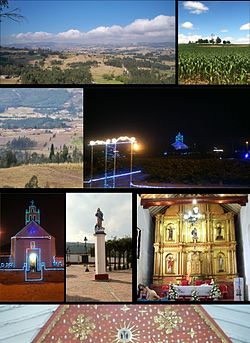Oicatá
| Oicatá | |||
|---|---|---|---|

Photos of Oicatá
|
|||
|
|||
 Location of the municipality and town of Oicatá in the Boyacá Department of Colombia |
|||
| Coordinates: 5°35′N 73°19′W / 5.583°N 73.317°W | |||
| Country |
|
||
| Department | Boyacá Department | ||
| Province | Central Boyacá Province | ||
| Founded | 9 May 1539 | ||
| Founded by | Pedro Ruiz Corredor | ||
| Government | |||
| • Mayor | Franky Fonseca Salamanca (2016-2019) |
||
| Area | |||
| • City | 59 km2 (23 sq mi) | ||
| Elevation | 2,815 m (9,236 ft) | ||
| Population (2015) | |||
| • City | 2,834 | ||
| • Density | 48/km2 (120/sq mi) | ||
| • Urban | 301 | ||
| Time zone | Colombia Standard Time (UTC-5) | ||
| Website | Official website | ||
Oicatá is a town and municipality in the Central Boyacá Province, part of the Department of Boyacá, Colombia. The urban centre is situated on the Altiplano Cundiboyacense at an altitude of 2,815 metres (9,236 ft) and a distance of 153 kilometres (95 mi) from the national capital Bogotá and 15 kilometres (9.3 mi) from the department capital Tunja. It borders Cómbita and Tuta in the north, Chivatá and Tunja in the south, Chivatá in the east and in the west Cómbita and Tunja.
The name Oicatá comes from Chibcha and means "Domain of the priests" or "Hailstoned farmlands".
The municipality was founded on May 9, 1539 by Pedro Ruiz Corredor. Before the Spanish conquest it was the territory of the Muisca, which was the most developed in the country socially, culturally, and in productivity. Post-conquest governmental power was exercised by the Governor General, who was directly appointed by the King of Spain.
After several centuries of Spanish rule, and after fierce battles, the people won their freedom from Spain in the Battle of Boyacá, where on August 7, 1819, troops under the command of Simón Bolívar defeated the Spanish forces.
In 1821 the Constitution of Cúcuta divided the country into departments, the departments into provinces, provinces into counties, and counties into parishes, establishing Boyacá Department as an administrative entity comprising the provinces of Tunja, Pamplona, Socorro and Casanare.
...
Wikipedia


